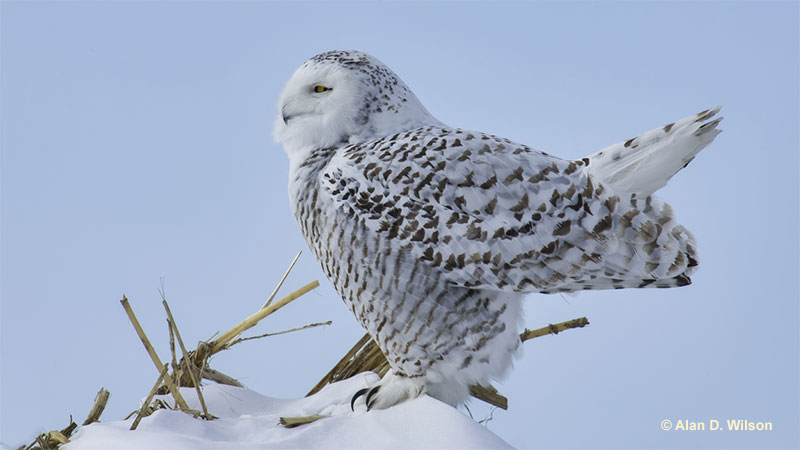
Wisconsin is a lovely mosaic of woods, wetlands, farms, and urban areas. It’s also a great place to see owls!
Since most of the owls in Wisconsin are only active at night, they can be tough to see. However, several species are also common and even live in parks and towns.
Which owls have you seen in this state? See this article to identify and learn all about the owls of Wisconsin!
On this page
Owls You Can See in Wisconsin
According to eBird data and USGS data, seven owl species are commonly encountered in Wisconsin. Four other rare species are also occasionally seen in the state.
To make a reliable list showing all the owls of Wisconsin, we researched eBird data and organized the owls from most common to least common.
We also included tips for identification and information about their behavior. We hope this list helps!
1. Barred Owl
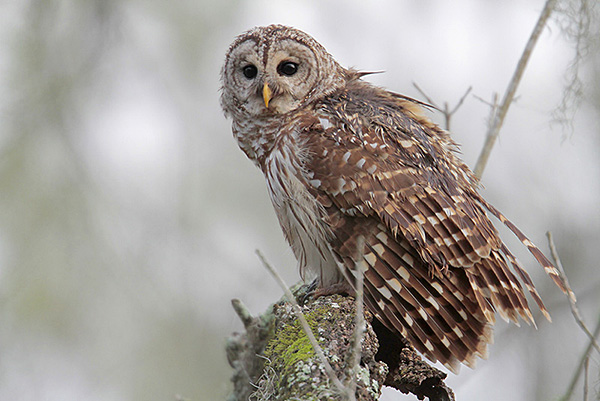
Photograph © Greg Lavaty.
- Range: A permanent resident in most forested areas in Canada, parts of some Pacific Northwestern states, and most of the eastern USA.
- Length: 21 inches
- Wingspan: 42 inches
- Call: Makes loud hooting and caterwalling sounds, “Who cooks for you?! Who cooks for youaaaal!”
The Barred Owl is a medium to large owl with a round head and a narrow black border on its pale gray face. It has dark brown upperparts with white markings, and dark brown streaks on its belly.
This species also has a yellowish beak and dark eyes. Both sexes look the same except that females are a bit larger than males.
The Barred Owl flaps and glides on big, broad wings. It also has a medium-length, broad tail with a few dark brown bands.
Key Identifications:
- Big owl with a round head that has white marks on dark brown upperparts, and dark brown streaks on pale underparts.
- Perches and swoops through wooded areas at night but can also be active in the day.
- Nests in tree cavities and in abandoned nests of crows and hawks.
- Catches a wide variety of small animals.
The Barred Owl lives in deciduous and coniferous forest and woodlands. It nests in the abandoned nests of raptors and crows, and in tree cavities. Barred Owls are recognized by their round head and dark streaks on pale underparts. Male and female Barred Owls make bizarre, loud laughing sounds when they call together.
2. Great Horned Owl
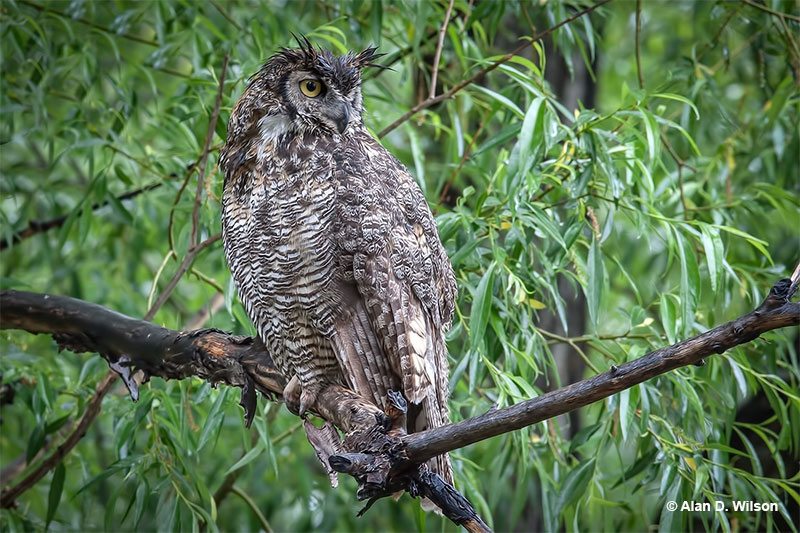
- Range: Permanent resident in much of Alaska, Canada, and the USA.
- Length: 22 inches
- Wingspan: 44 inches
- Call: Makes a low, gruff, “hooo, hoo hoo hoo hoooo”.
The Great Horned Owl is a big, bulky owl with big ear tufts and a black beak. It is mottled gray and brown, has a rufous or gray face, and fine black barring on its underparts. This owl also has a white throat and some dark marks on its breast.
Males and female Great Horned Owls look the same but females are larger. They also have a medium-length tail with dark bands, and long, broad wings.
Related: How long do owls live?
This nocturnal owl species lives in every possible habitat, including urban areas.
Key Identifications:
- Big, bulky brown or gray owl with ear tufts and fine barring on its underparts.
- Nests in old stick nests of other large birds, on ledges, and in other situations.
- Watches from a perch or glides over open habitats at night, to catch mammals and some birds on the ground.
The Great Horned Owl lives in every type of habitat in much of North America, including Wisconsin. It nests in old stick nests of hawks and other birds, or on ledges, and other situations. Great Horned Owls are easily recognized by their big, bulky size, ear tufts, and finely barred underparts. The talons and grip of this species are so strong, once closed, 28 pounds of pressure are needed to open them!
3. Eastern Screech-Owl
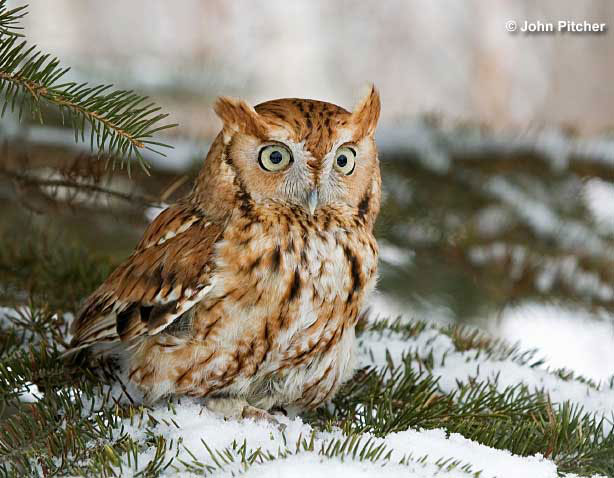
- Range: Permanent resident in parts of southeastern Canada, and in much of the eastern USA.
- Length: 8.5 inches
- Wingspan: 20 inches
- Call: Makes a rather high-pitched, descending whinny call, and a tremulous, vibrating call on the same pitch, “wududududududududududu”.
The Eastern Screech Owl is a small owl with ear tufts. It can be reddish, brown, or mostly gray, has “V”-shaped pale eyebrows, and some black on the edge of its face. It is also mottled above with some white spotting, and has pale underparts with dark barring and streaks.
Males and females look alike but females are a bit larger. This species also has yellow eyes, a pale yellow-gray beak, and some white bands on its broad tail.
Eastern Screech-Owls flap and glide on long, broad wings.
During the day, this owl hides in holes, or in dense vegetation. Eastern Screech Owls are common owls in Wisconsin.
Key Identifications:
- Small owl with ear tufts and mottled brown or gray plumage that lives east of the Rocky Mountains.
- Lives in a variety of wooded and park-like habitats.
- Nests in tree cavities and nest boxes.
- Swoops down to the ground catch a variety of small animals at night.
The Eastern Screech-Owl lives in wooded and park-like habitats east of the Rocky Mountains in Canada and the USA. Eastern Screech-Owls are identified by their ear tufts, small size, range, and voice. This species is more common than most people realize and often lives in urban situations. Put up a nest box in the backyard and one might move in!
4. Short-eared Owl
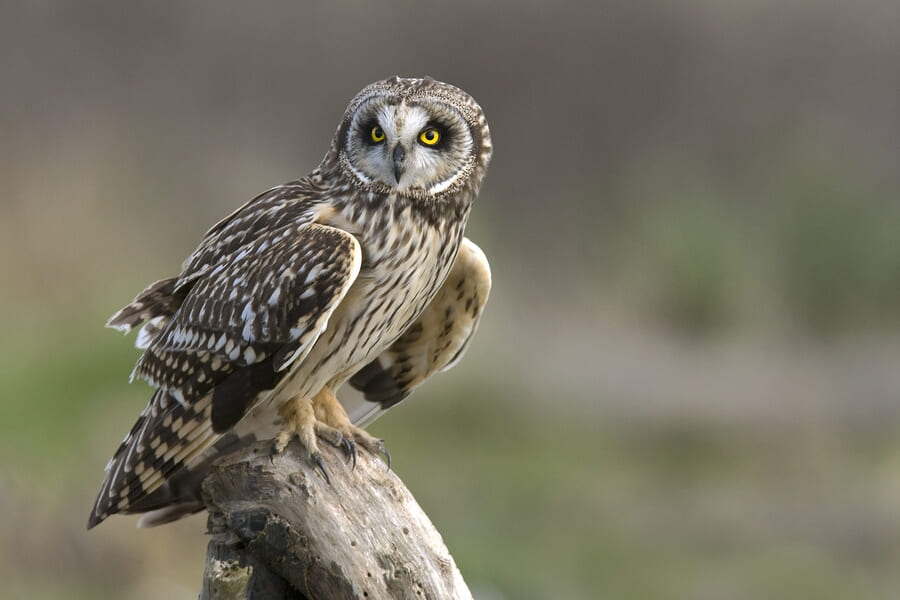
- Range: Summer resident in Alaska, Canada, and the western and central USA. Northern birds migrate to the USA, south to California and Texas.
- Length: 15 inches
- Wingspan: 38 inches
- Call: Makes a hoarse, raspy, cat-like call, “rehw”.
The Short-eared Owl is a medium-sized, pale brown owl with dark eye patches on a pale face. They have a dark breast and streaks on pale underparts. This species has long wings with buff wing patches.
Both sexes look similar but females are a bit larger and usually darker and buffier.
This owl is active day and night in open fields.
Key Identifications:
- Medium-sized pale brown and buffy owl with very short ear tufts.
- Dark eye patches on a pale face and long wings with buff patches near the wingtips.
- Nests on the ground in dense vegetation.
- Glides over open fields to catch small animals on the ground.
The Short-eared Owl lives in open habitats in Alaska, Canada, and much of the USA. Short-eared Owls can be spotted in Wisconsin. It nests on the ground in dense vegetation. This species is identified by its dark eye patches on a pale face, and long wings with buff patches near the wingtips. On account of their long migrations, Short-eared Owl have become established on Hawaii, and the Galapagos Islands.
5. Snowy Owl
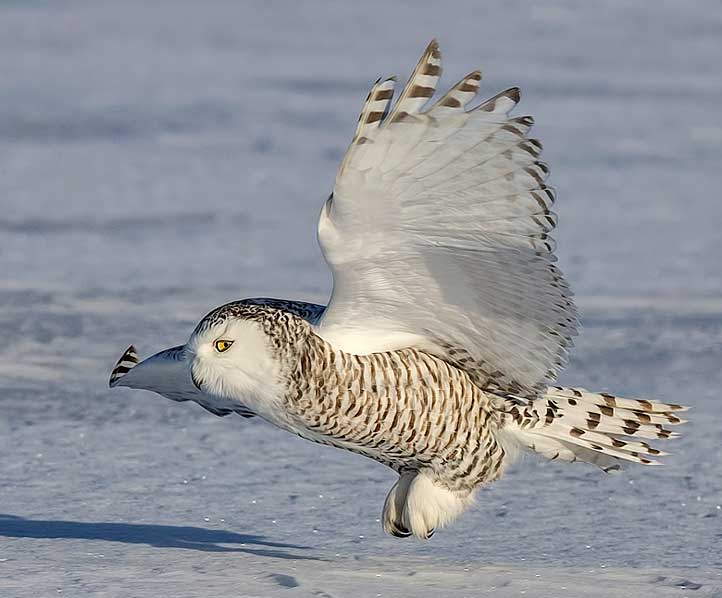
- Range: Summer resident in northern Alaska and northern Canada. It winters in Canada and the northern USA.
- Length: 23 inches
- Wingspan: 52 inches
- Call: Usually quiet but occasionally makes a low, gruff call, “whew…whuh”.
The Snowy Owl is a big, mostly white owl with a round head and yellow eyes. Some males are mostly white but most have some small dark marks. Females and young birds have white faces and varying degrees of black barring.
Females are a bit larger than males and have more black markings than males. Snowy Owls also have long, broad wings and a broad tail.
This owl species is active during the day and lives in wide-open habitats.
Key Identifications:
- Big white owl with a round head, and varying degrees of black or dark gray barring and spots.
- Lives in tundra and winters in wide open habitats.
- Nests on the ground, on elevated spots in Arctic tundra.
- Watches from a perch and glides low to catch small animals on the ground.
The Snowy Owl lives in Arctic habitats but also winters in open areas in Alaska, Canada, and the northern USA. It nests on elevated spots on the ground in the Arctic tundra. This species is unmistakable; it is the only big, mostly white owl. The wide open terrain at airports are ideal for this species and are some of the best spots to see a Snowy Owl.
6. Northern Saw-whet Owl
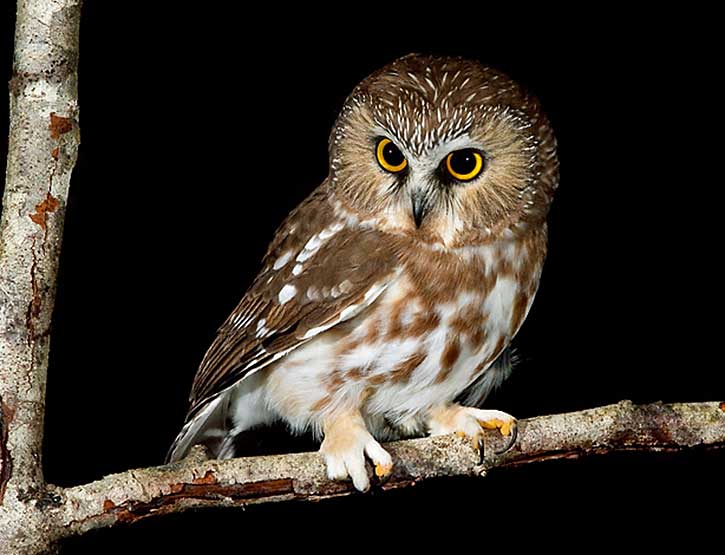
- Range: Lives in coniferous and mixed hardwood forests of Alaska, a large area of Canada, and parts of the northern and western USA.
- Length: 8 inches
- Wingspan: 17 inches
- Call: Makes a repeated tooting whistle call, over and over, “tu, tu, tu, tu, tu, tu, tu, tu, tu”.
The Northern Saw-whet Owl is a small, dark brown owl with a round head and brown streaks on white underparts. It also has some pale streaks on its head, a brown and white face, and some white spotting on its back.
Both sexes look the same but females are a bit larger. This species also has yellow eyes, a dark beak, longish, rounded wings, and a short, broad tail.
This nocturnal owl lives in forested habitats.
Key Identifications:
- Small, dark brown owl with a round head, broad white eyebrows, and thick dark streaks on pale underparts.
- Occurs in dense coniferous and mixed forest.
- Nests in old woodpecker holes and can use nest boxes.
- Swoops down to catch insects and small animals at night.
The Northern Saw-whet Owl breeds in coniferous and mixed forest in Canada and the northern and western USA, including Wisconsin. It nests in old woodpecker holes and is identified by its small size, round head, thick white eyebrows, and thick streaks on pale underparts. The name of this owl refers to the similarity of its call to the sound made by sharpening an antique old saw blade.
7. Long-eared Owl
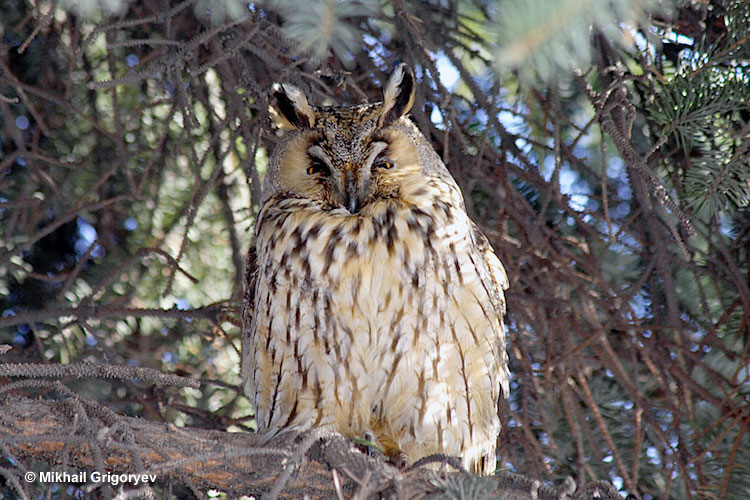
- Range: Migrant in southern Canada, resident and winters in much of the USA. Absent from parts of the Pacific Northwest and southeastern states.
- Length: 15 inches
- Wingspan: 36 inches
- Call: Makes a single, one second long “Hooo!” call at regular intervals.
The Long-eared Owl is a medium-sized, slender owl with long ear tufts. It has an orange face, is mottled gray above, and has dark brown streaks and marks on pale underparts. This owl also has long wings with a rufous patch in its primaries.
Male and female Long-eared Owls look similar but females are larger. This owl species also has yellow eyes, and some pale markings between its eyes and around its dark beak.
This nocturnal owl frequents coniferous woodlands near meadows.
Key Identifications:
- Medium-sized, slender owl species with long ear tufts, orange on its face, and long wings with an orange-brown patch near the wingtips.
- Occurs in coniferous and mixed forests near meadows, bogs, and other open areas.
- Nests in old crow, magpie, and hawk nests.
- Glides over open habitats near forest at night to catch small animals on the ground.
The Long-eared Owl occurs in forest with open areas in Canada and much of the lower 48 states. This owl nests in old magpie, crow, and hawk nests. Long-eared Owls can be recognized by their long ear tufts, orange face, slender appearance, and long wings with orange-brown patches near the wingtips. Wintering roosts of Long-eared Owls in Serbia can host thousands of birds!
Rare Owls in Wisconsin
8. Barn Owl
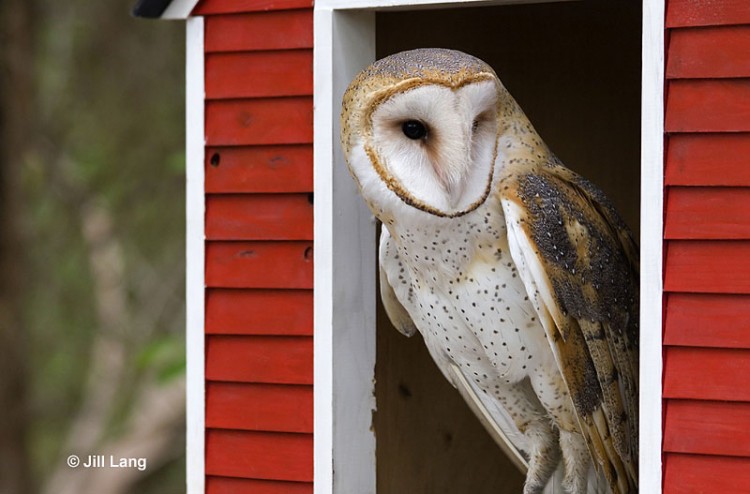
- Range: In Canada, occurs mostly in southwestern British Columbia. In the USA, they live in many areas but are absent from mountains and cold, northern regions. They range north to Washington, Nebraska, Iowa, and New York.
- Length: 16 inches
- Wingspan: 42 inches
- Call: A shrill, loud, hissing “shriiiiii!”
The Barn Owl is a medium to large, pale owl with golden tan and gray upperparts, and white underparts. It has a distinctive, white, heart-shaped face.
Both sexes are alike but females are a bit larger than males and have buff on their chest.
In flight, Barn Owls look like a large, pale, moth-like bird with a big, rounded head.
This owl hunts in grasslands, farms, and other open habitats.
Key Identifications:
- Large pale owl with a heart-shaped face.
- Glides and flutters over fields and other open areas at night.
- Nests in tree cavities, crevices in church steeples and other structures, and next boxes.
- Preys on rats and other small animals.
The Barn Owl lives in many urban and open habitats in regions with mild or no winters. It nests in church steeples, barns, tree cavities, and other similar situations. They are uncommon owls in Wisconsin. This species is easily recognized by its white, heart-shaped face, and unstreaked, pale plumage. Barn Owls have incredible hearing that helps them catch prey in total darkness.
9. Great Gray Owl
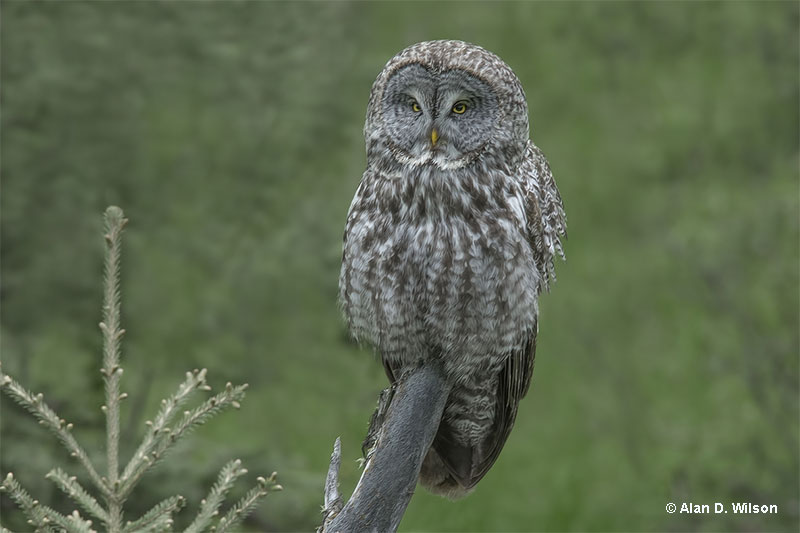
© Alan D. Wilson
- Range: Permanent resident in Alaska, northern Canada east to Ontario, and in the northern Rocky Mountains south to Yellowstone. Some birds winter in the northern USA and southeastern Canada.
- Length: 27 inches
- Wingspan: 52 inches
- Call: Makes ten, low hoot calls, the first and final notes lower than the others, “woot…hoo..hoo..hoo..hoo..hoo..hoo..hoo..hoo..hoo”.
The Great Gray Owl is a huge owl with a big, round head, and is dark gray with some pale mottling. It has a narrow black border on its face and two white marks on its throat.
Both sexes of the Great Gray Owl look the same although females are larger. They have yellow eyes, a yellowish beak, and a broad, medium-length tail.
This owl species also has long, broad wings with dark barring and a buffy patch near the wingtips.
Key Identifications:
- Huge, dark gray owl with a big round head, and two small white patches on its throat.
- Lives in boreal forests with bogs and other openings.
- Nests in old raptor nests and on platforms.
- Catches voles and other small rodents on the ground.
The Great Gray Owl in boreal forests with open areas in Canada and the northwestern USA. It nests in old raptor nests and on platforms, and is identified by its big size, and dark gray plumage with a couple small white marks on its throat. Great Gray Owls routinely catch rodents by diving into and breaking through, heavy, hard snow.
10. Northern Hawk Owl
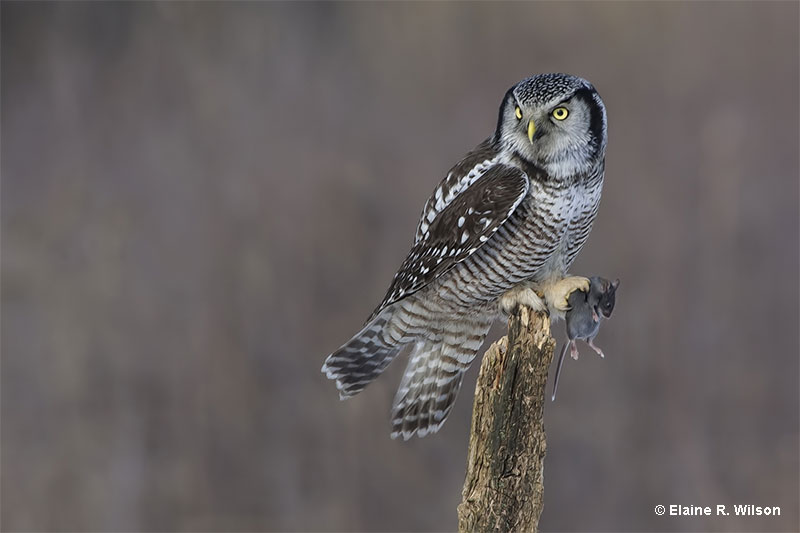
© Elaine R. Wilson
- Range: Permanent resident in Alaska and a large area of Canada. In the winter, some birds reach the northern USA and southern Canada.
- Length: 16 inches
- Wingspan: 28 inches
- Call: Makes a long, somewhat high-pitched bubbling call.
The Northern Hawk Owl is a slender, smallish to medium-sized owl with a square-shaped head and long, pointed tail. It has a black and white head, and fine barring on pale underparts. It also has some white spotting on dark brown upperparts.
Both sexes of this owl species look the same although females are a little bit bigger than males.
Northern Hawk Owls perch on the top of trees. They fly with deep, quick wing beats and glide low over the ground.
This diurnal owl frequents coniferous forest habitats.
Key Identifications:
- Smallish to medium-sized, slender black and white owl with a square head, white spots above, and dark barring on pale underparts.
- Lives in boreal forest but some also winter in semi-open areas just south of its breeding range.
- Nests in tree cavities and in broken off stubs of dead trees.
- Watches from a high perch before quickly flying and gliding low to catch prey on the ground.
The Northern Hawk Owl lives in boreal forest in Alaska and Canada, some also winter in southern Canada and the northern USA. They can be recognized by their black and white plumage, square head, and long tail. This species has incredible eyesight; it can see a small mammal a half mile away!
11. Burrowing Owl
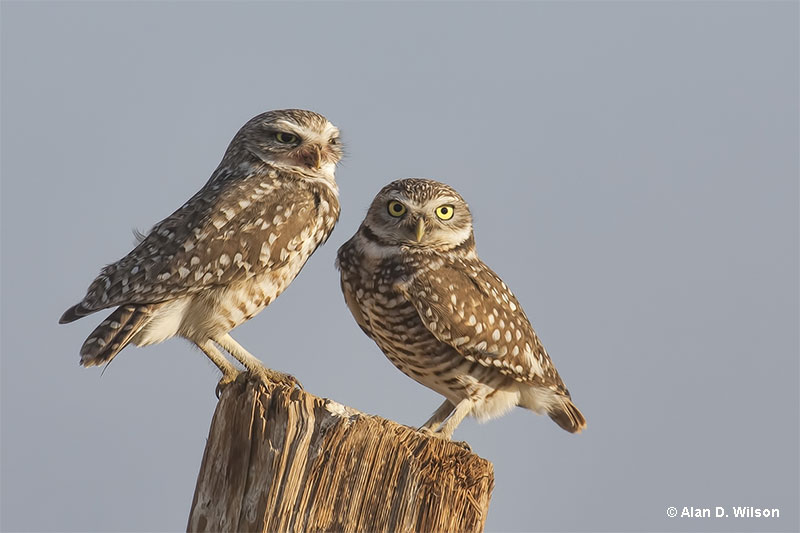
© Alan D. Wilson
- Range: Summer resident in central-southern Canada, the Great Plains, and much of the western USA. Permanent resident in California, Texas, and Florida.
- Length: 9.5 inches
- Wingspan: 21 inches
- Call: Makes a raspy, chattering call, “rap, rip,rip,rip,rip”, and a quail-like, “whup waaah!”.
The Burrowing Owl is a small, long-legged owl with a white throat and white eyebrows. It has a round head, is dark brown with white spots above, and has pale underparts with dark barring.
Males and females look alike although females are a bit larger. Young birds are uniform dark brown and buff.
Adult Burrowing Owls in Florida are more heavily marked below than western birds but juveniles from Florida are paler.
The Burrowing Owl is active day and night in grasslands, deserts, and other open habitats.
Key Identifications:
- Small, long-legged owl with a round head, and some brown barring on pale underparts.
- Lives in grasslands and other wide-open habitats.
- Nests in burrows made by prairie dogs and other animals although birds in Florida make their own burrows.
- Catch small animals on the ground at any time of the day or night.
The Burrowing Owl occurs in open habitats in south-central Canada, the western USA, and Florida. It nests in burrows. Burrowing Owls are easily identified by their small size, round head, barred underparts, and terrestrial behavior. Like some other animals that live in burrows, this species is more tolerant of carbon dioxide than other birds.
Frequently Asked Questions – Owls in Wisconsin
What is the most common owl in Wisconsin?
The most common owl in Wisconsin is the Barred Owl. According to eBird sightings and other data, the Barred Owl has been seen more often than any other owl species in the state.
Are there owls in Milwaukee?
Yes, there are owls in Milwaukee. At least three species are commonly found in the city limits.
Are there white owls in Wisconsin?
Yes, there are white owls in Wisconsin. The Snowy Owl is a regular winter visitor.
How do you attract owls in Wisconsin?
You attract owls in Wisconsin by installing nest boxes for Eastern Screech-Owls and maintaining good habitat for birds and wildlife. Preserving forest and meadows, and maintaining a yard with native vegetation, big trees, and wood piles are all good ways to attract owls.
What animal screeches at night in Wisconsin?
Owls are some of the animals that screech at night in Wisconsin. The Great Horned Owl and other owl species can make screeching sounds.
Read next: Common duck species in Wisconsin

